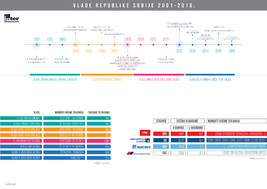Active projects
Active researches
Active evaluations
ECONOMIC TRENDS IN SERBIA IN THE NEW MILLENNIUM
Release date: 24.03.2017.
 The democratic changes in Serbia have emerged from Milosevic’s fall that coincided with the beginning of the new millennium. The period after that was marked by many political and economic challenges that are interpreted in different ways by different political and social factors. Hence, it is a standard practice in the political scene of Serbia that representatives of the Government accuse their predecessors of failures and the bad state of the economy. This has happened before and it's happening now.
The democratic changes in Serbia have emerged from Milosevic’s fall that coincided with the beginning of the new millennium. The period after that was marked by many political and economic challenges that are interpreted in different ways by different political and social factors. Hence, it is a standard practice in the political scene of Serbia that representatives of the Government accuse their predecessors of failures and the bad state of the economy. This has happened before and it's happening now. Was it really so bad before compared to today, and are those to be blamed for the current economic situation in Serbia only in our recent past?
In order to find some answers to this question, the Institute for Territorial Economic Development - InTER developed infographics showing the trends of the eight key economic indicators in Serbia in the period 2001-2016. The indicators are divided into four periods that have marked the modern political history of Serbia: the initial period in which the Government of Zoran Djindjic and Zoran Zivkovic, followed by the period of two Governments of Vojislav Koštunica, then the Governent of Mirko Cvetkovic as a special period, and finally the Governments of Ivica Dacic and Aleksandar Vucic.
We have deliberately left out the analysis of the results because we want everybody to draw their own conclusions.
Note: The Institute for Territorial Economic Development – InTER is an independent center for public policy research. With these infographics, we do not want to directly influence the current presidential elections in Serbia, but to contribute to quality social debate about the economic trends in Serbia. Hence, we herewith dissociate in advance with any possible abuse of InTER in the election campaign.
Publications
Resource center
- 08.07.2016.InTER Newsletter 16 Eng
- 20.05.2016.InTER Newsletter 16










